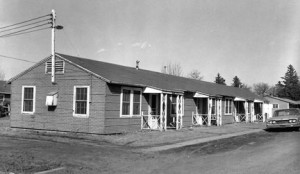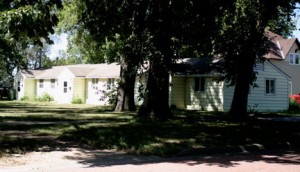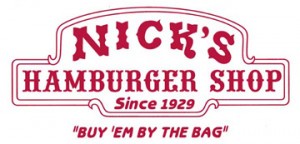Campus housing has changed a lot since WWII
If you graduated before 1965 and lived where the new Jackrabbit Village is today, you’d be walking through tall corn.

By the winter of 1946, about 100 small trailers were sited in College Grove to provide housing for returning single veterans.
The Village is dominated by three well-adorned residence halls with every modern contrivance known to man, like Wi-Fi and computer-connected laundry machines so students can know if they’re in use. Architectural beauty spires four stories on the once grimy footprint of Trailer Lane for single vets, and some corrugated tin-encased Army barracks converted to nanoscale apartments for married vets. When married couples moved in a year after WWII, the area came to be called Fertile Acres. More showy Jackrabbit Village appendages on the old Fertile Acres site are on the way. Lava lamp dorms like Mathews, Young and Pearson are getting facelifts. And there’s an expanded and impressive University Student Union just down the promenade. The area is no longer your grandpa’s College Grove. The remains of the campus’ tumbledown trailer park and married student housing areas of the post-war 1940s and ’50s, complete with gravel roads sprinkled occasionally with discarded motor oil to keep the dust down, are now embellished with modernity, like flat-screen TV’s, recycling bins, and a convenience store. Where once coed-housewives chiseled fifty-pound cubes of frozen lake water into their apartment ice boxes, silently purring Village refrigerators now protect today’s dip, pickles, and pop.

Married student housing, as shown in this early to mid-1950s photo was brought onto campus (at the location of what is now Jackrabbit Village) from a Nebraska military base. Gradually, the corregated tin siding was replaced with plywood and tar paper, which was made to look like fake brick.
Big wooden matches once lit every unit’s smelly fuel oil stove. Now a flip of a switch awakens electric fireplaces with a whoosh. Fertile Acres ain’t what it used to be. Three weeks before the WWII ended Aug. 15, 1945, college officials wondered what to do about housing. By late 1945, a hundred trailers built for war and not comfort were on campus from bases in Wisconsin. By January 1946, they lined Trailer Lane. More good news soon came for married students. A platoon of army barracks from Nebraska were being dumped on hurried foundations to be divided into apartments, wired, watered, and covered with tarpaper roofs for monthly rents of $24.50. Gradually as money was available, the corrugated tin siding was replaced with ply wood. Young married couples moved in and loved it. Neighborhood parties, potlucks, shared bags of ten-cent Nickburgers, and baby sitters were within shouting distance. From home to class took just minutes. Walls between apartments were cardboard thin. Retired Vice President for Academic Affairs Harold Bailey, unable to find housing after he was hired in the Pharmacy Department in 1951, remembers when an errant tricycle wheel guided by a young rider next door crashed through a wall into the Bailey living room. By 1960, the housing shortage was solved. West Men’s Hall (Scobey) was built. Trailers were trashed. Barracks were sold for chicken sheds and grain storage.

Three barracks survived service in the military and on campus to become rental units at 122 Fifth Ave. S. They are testimony to what new siding and paint can do.
In the late 1960s some of the barracks lumber was used to build a ramshackle indoor track about where the Student Union is today. The product of Stan Marshall, athletic director; and Jay Dirksen, track coach, the tunnel-like track was lighted every twenty-five or so yards with one light bulb hanging from the ceiling. It wasn’t a building, but a round, unheated, above-ground tunnel that runners could use in the winter and affectionately called the “hippodrome.†Miraculously, three barracks were moved off campus and still remain in Brookings as rental units, although I suspect they’ll now run you a little more than $24.50 a month.








